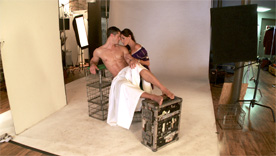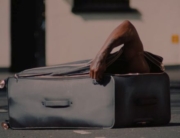If you scan the crowds of women eagerly waiting to get into romance writers conventions to meet their sheroes or those attending live readings, nodding as authors read from their latest novels, you might think you recognize the faces of relatives, friends, or workmates in Laurie Khan’s moving, feel-good documentary. That’s as it should be. The romance genre is a quiet “behemoth” in the publishing industry, outselling mystery, science fiction, and fantasy combined, and more and more readers are coming out of the closet and proclaiming their love for the books.
Producer/writer/director Khan, a resident scholar at Brandeis University’s Women’s Studies Center, has produced two other women-centric films, A Midwife’s Tale and Tupperware! For this documentary, she immersed herself in the romance community for three years, gaining extraordinary access to five romance authors, one wannabe, and the “global sisterhood” that supports and encourages them.
We meet Mary Bly, a Shakespearean scholar who writes historical romances under the name Eloisa James and who kept her “night job” secret until she gained tenure; African American romance pioneer Beverly Jenkins, who took up her pen when she didn’t see enough people who looked like her in romance; former surgeon Len Barot, a writer of lesbian romance fiction under the pen names Radclyffe and L.L. Raand who also runs a publishing house with more than 140 authors; writing partners and best friends Susan Donovan and Celeste Bradley, both divorcees, single moms, and New York Times best-selling authors; and Australian environmental consultant Joanne Lockyer, aspiring romance author and mentee of American author Elizabeth Essex.
One oft-stated point is that romance has been overlooked and underappreciated because it’s primarily by women for women. Jenkins, Donovan, and Bradley are particularly wry in their assessments. At one point, Jenkins laughingly calls action movies starring Sylvester Stallone and Arnold Schwarzenegger the male equivalent of romance because of their happy ever after endings. Other industry heavy hitters, such as authors Jennifer Crusie, Jayne Anne Krentz, Brenda Jackson, and mega-seller Nora Roberts, talk about the industry and their early struggles. Particularly touching are visits with Kim Castillo, a Hoosier who parlayed her love of romance into a new career maintaining social media sites for romance authors, and an emotional tour of the South with Jenkins and her fans.
The articulate, diverse, and approachable spokeswomen (and a few men) in Love Between the Covers help to bust a few myths about romance and the people who read and write it. But the film offers some new myths of its own: a unified, loving community of happy campers, seemingly all on the same page and only there to help each other. There’s no discord except for some rancor directed at their ex-husbands by Donovan and Bradley, and erotica authors and writers of gay romance, mostly straight women, are absent from the narrative. That said, this portrait of a powerful community of women doing what they love and loving what they do is life-affirming. It might tempt viewers to crack open a romance novel, or at least have a newfound respect for the women who write them.–Liz French, former managing editor, RT Book Reviews (formerly Romantic Times)

















Leave A Comment